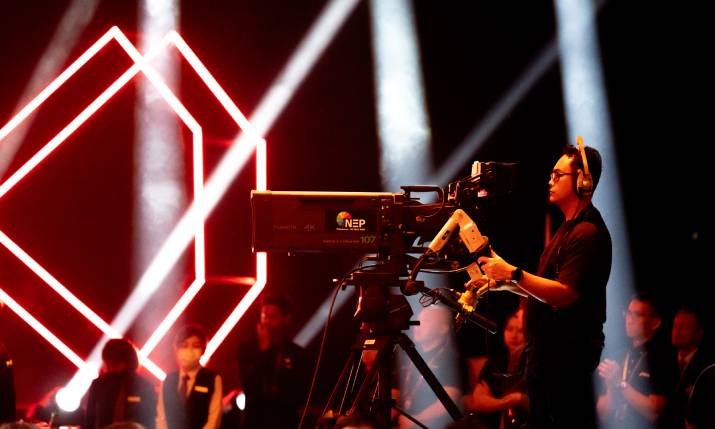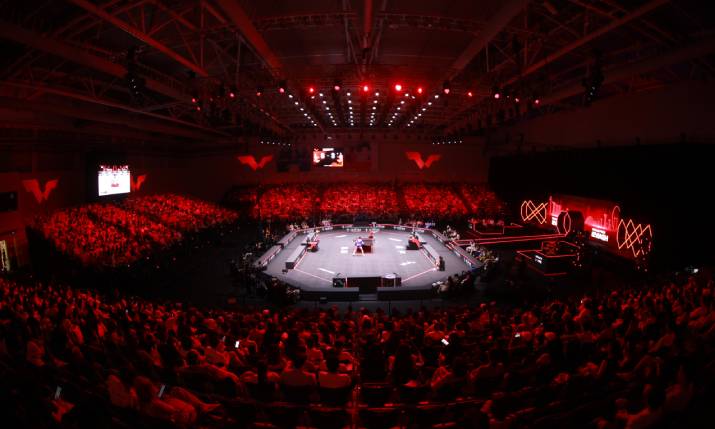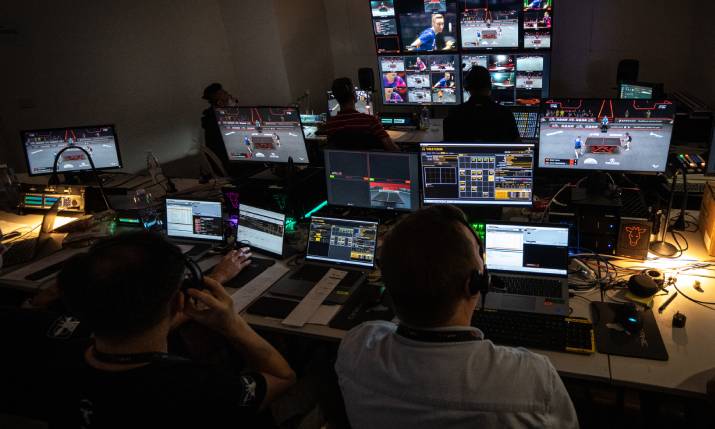Fanatical fans: IMG on bringing the world of table tennis to a new global audience for WTT

IMG works in partnership with World Table Tennis to create an exciting new broadcast for the sport
IMG is the production partner for World Table Tennis (WTT), an association that was created in 2021 to grow the sport internationally. While WTT developed the overall image of the series, IMG has been responsible for creating the production and bringing the sport to life on TV screens. From his base in Singapore, SVG Europe spoke to Rob Peile, vice president of production in Asia for IMG, to find out more.
When did you get involved with WTT and how do you work together?
We entered into our long term strategic partnership with WTT in January 2021. We actually did our first event for them at the tail end of 2020, which was in Macau, which is where it really came alive. We just wanted to help them grow the sport and see what the potential of the sport was, not only from a visual perspective, but from a distribution standpoint.
I think the great thing about our partnership is we really do work hand in glove. WTT, from a creative perspective, came out with a really great, strong brand for WTT, and they also had some really great concepts of how they were going to transform the arena experience – what I would call the field of play – and how it was going to look, the feel, the darker colours, and step away from always having four table tennis tables in a big sports hall together, to having one really incredible feature court.
As producers, as IMG, that’s fantastic because that then gives you the ability to concentrate your cameras on what I would call a clean field of play. You don’t have to worry about other games happening in the same hall. You can drop the lights, you can create a mood. And so when we came on board, hearing what WTT’s plans were for the sport was really inspiring for us as producers.
Once we had the general look and feel of what WTT wanted to achieve, and the branding, and the colours and all of those things, we then spent a lot of time talking about how the arena was going to be laid out, what the entrances were going to be, where the screens were going to be, where our cameras could be. And it was really a collaborative experience right from the very beginning, and it was really rich and rewarding; as producers, a lot of the time, you just get given what you have to shoot, but we felt like we really added value and we were coming at it from lots of different angles.
We found a really fantastic consensus in how WTT could be presented to the global stage.
Read more Ping pong for the masses: Bringing an old sport to a brand new audience with World Table Tennis
What has been your overall goal with the WTT productions?
Table tennis, like every sport, has a lot of fanatical fans, and they’ll watch table tennis regardless of how it’s shot, regardless of who’s playing. What we really wanted to do was open up table tennis to a brand new audience, an audience that maybe didn’t really understand how fast-paced the game was, how agile the athletes were.
Very rarely, as producers, do you get a chance or an opportunity to reinvent a sport. We literally had a blank sheet of paper. And that was incredibly exciting to be a part of.
IMG uses its internal company, fibre service provider Cingularity, for distribution of signals from the WTT events via Cingularity’s fibre and back to Stockley Park for global distribution on IP, “as opposed to satellite, which has been very successful,” says Peile. “We’ve done that not only with WTT in the Asian region, but we’ve done that on our LPGA jobs as well. So delivering more of our signals via IP is an area that I think will definitely grow and expand in the future.”
What is the most innovative thing you have implemented for this production?
So the big change that we made was the main camera, what we call the main camera angle, that the sport is presented. The sport was traditionally presented from a side-on camera, a little bit like tennis, so you see the length of the court.
Because we’d only really had exposure watching table tennis on the Olympics every four years, it wasn’t something that was on our radar. What we really discovered with the camera angle that had been traditionally used year after year, decade after decade, is that a lot of the gameplay was actually blocked by one of the players; one of the players was always in front of a very small ball.
We started experimenting with moving that camera to a three quarter shot, and then to a side shot. Once we watched the game being played from a side shot, we were staggered ourselves at how much the players move around and how fast the game is.
We sold this idea to WTT that this really gives more onus on the athleticism of the athletes, because you can see it. You can really see how fast the game is. Also the distances and the reaction times that these guys and girls react to are staggering to watch. When table tennis is good, it is electric. And that’s what it’s really brought out to the viewers globally.

The arena for the Singapore Smash takes traditional viewing of ping pong and turns it into a spectacle for viewers
And what about the graphics? They are important to show new viewers what’s going on in the game.
One of the things we really wanted to do was refresh the graphics to give them a much more modern and clean look. Once we had the field of play to work with, it was pretty obvious what we needed to do with the graphics. The good thing about having IMG work so closely with WTT – and not an independent production company that doesn’t have a really close relationship – is we designed a set of graphics, and then we looked at how that was going to work on the field of play. So when you watch our coverage, everything has got the same look and feel and tone to it. We brought in a longtime partner of ours called Girraphic, who are an Australian-based graphic company. I’ve worked with them extensively in my time in Australia and also when I worked at Red Bull in Austria.
We created a suite of graphics that were what I would call a standard suite of graphics, leaderboards, scoring, etc. What Girraphic do on a long term contract like this is that our producers can go to them and say, “hey, we’ve got an idea for a graphic, can you produce that?”, and they help us realise the product and add graphics that enhance the experience for the viewers at home.
We’ve also experimented alongside WTT and some of the partners that they’ve brought on with what I would call augmented artificial intelligence-powered graphics, where we’ve set up cameras in the arena that scan the table, ball follow, etc; it can work out where the ball has been placed on the table because it’s constantly scanning the table. We’ve experimented two or three times now on live broadcasts to take that enormous treasure trove of data and pick out the bits that are relevant to tell the story in a much better way; something simple like ball speed.
What we need to do is feed the fans who already love and know and enjoy this sport with data that enhances their experience, but we also need to deliver data that doesn’t overwhelm the new fan. We need to dumb that data down a little bit and we’re in the process of doing that and adapting that. I think in the coming years, you’ll see a much stronger suite of graphics on our broadcast.

Crew from IMG working hard to broadcast the Singapore Smash 2024
How important to this production is the crew that you’ve bought together for it?
One of the most important things in the broadcast that we’ve introduced with WTT for the first time is a core production team who are taking that look and feel and the lessons from the previous events onto all the other subsequent events, so that those lessons don’t get lost. So we have an executive producer, a senior producer, and a great production management team who are across every single event, every single year. We also call upon a bank of Singaporean freelancers as well that we work with quite heavily; the advantage there is that we do a lot of events in China, and the majority of our production team speak Mandarin, they speak Cantonese, and they speak English.
So by giving the broadcast production a core governance team, it doesn’t matter whether you are in Bangkok or you’re in China or you’re in Singapore or you’re in Saudi Arabia, the product always looks the same. I think that is one of the biggest advantages to us coming on board, that we’ve got a team who takes the lessons across so it’s got a consistent look and feel, so the product looks the same, and the broadcasters know what they’re going to get.
In the old days, you might get a really crappy production out of Bangkok, but a really great production out of England, and a great production out of China; it was really up and down. But this way, WTT know what they’re going to get because we’ve developed it together.
Also having a core production team that goes from event to event, that’s also really produced a really solid broadcast that everybody can be proud of. We are incredibly invested in the success of WTT.
And how are you going to continue to move this production forward? Is there anything specific that you want to develop or work on or bring more into production?
We’ve done 15 to 20 broadcasts by now so we’ve got into a nice steady rhythm. I think elevating the player’s personalities is something we’re constantly trying to work on; how to bring the personalities of the players out. It’s very hard to do. They’re very serious athletes and players. A lot of that more irreverent and what I would call personality-led content is now social media’s realm. We’re always testing new technology, new camera angles.

